Bonsai Trees
Case Histories
Maidenhair Tree - (ginkgo biloba)
Ginkgo Bonsai Style: Candle Flame
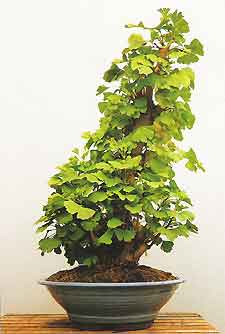
The ginkgo is a much misunderstood tree, thought by many to be more of a curiosity rather than suitable as bonsai material. Although having leaves and being deciduous it is closely related to the conifer family. The tree has a fascinating history, being the sole survivor of a family of trees that flourished over 350 million years ago, hence an alternative name 'fossil tree'.
The ginkgo seems to be a species that is either loved or hated by bonsai growers. Personally I have never understood how anybody could not be drawn to this undemanding and rewarding tree. I am one of those who really loves the ginkgo!
A bonsai enthusiast from our local society announced that he was selling some of his trees. I had heard that he owned a ginkgo and was informed that it was a fabulous tree, so I quizzed him about it. The next day I visited him and enjoyed looking around his collection. His ginkgo did indeed have the potential to be a good specimen and was certainly, to my mind, his best bonsai. I could not believe my luck!
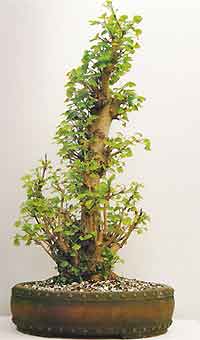
The tree had an interesting aged trunk, containing much 'chi chi' (trunk nodules), showing that it was very old and estimated to be around 80 years at that time. Although it was late summer, the branches were sparse and he said that it had not grown well that year as it was probably pot bound. I decided that I would never be able to create a mature trunk like this from a sapling ginkgo and was pleased that the bonsai needed much work, so that I could improve it myself. We bartered and agreed on a price.
When back home I began thoughtfully examining the ginkgo's possibilities. I really disliked the bright blue 'fruit bowl' shaped pot that the tree currently resided in and soon commissioned a large round drum pot. When the pot arrived several months later I was pleased to see that it had been made exactly as I had specified. Round is certainly my favourite shape for a bonsai pot and a drum pot with studs is perfection, as far as I am concerned! With round pots I feel that although the pot allows the tree plenty of space to grow, from the front it appears much smaller than a rectangular or oval pot of the same capacity.
Ginkgo Bonsai History: Training
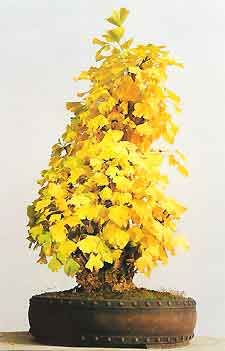
The next day the ginkgo was carefully removed from its existing pot and I could not have imagined what I was going to find. I was completely stunned when almost all of the soil fell off, together with many decayed roots, leaving only a few large roots and virtually no fibrous roots to speak of. Despite having been under cover for a while, the peaty soil, which contained hardly any grit, was sodden and the tree was in a very sorry state.
I was convinced that this ginkgo was destined for the compost heap, but was desperate to try and save it. All rotten roots were removed, leaving very little supportive root behind. The tree was planted in its new bonsai pot rather like a giant cutting, using a very gritty and open mix. I planted it more upright, tied it in well as having so few roots it was very unstable, and waited apprehensively to see if any buds would swell.
I was aware that ginkgo's are often late to leaf out and did not give up hope when my other bonsai started to grow and the ginkgo showed no signs of life. During its convalescence it was misted regularly and positioned in a cold and light greenhouse, where it was protected from hard frosts. Just as I was beginning to worry, I noticed that the lower buds had begun to show signs of green at their tips, although the top of the tree still appeared dormant - or possibly dead! My patience however was rewarded and the tree leafed out all over in a matter of weeks.
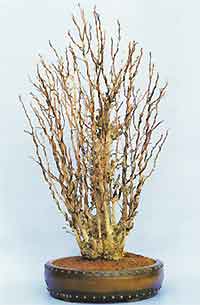
Ginkgo's are clearly very resilient as they would not have survived on the planet for so long had they not such a strong will to live. This was certainly apparent in this bonsai! I moved it outside and watered sparingly. The buds on the main part of the trunk were not growing at all, only the lower shoots. This was very unusual as normally a tree's most vigorous part is at the top, but not with this ginkgo, which had only one weak shoot growing near the top. I let the lower shoots grow unchecked all season so that the almost non-existent root system could begin to recover.
A year later and the main trunk was still refusing to grow. It was clear that the tree was healthy at this stage and so I completely leaf pruned all of the bottom shoots to force much needed strength back into the top of the trunk, but it still would not grow. I was convinced that persistence with this technique would pay off and leaf pruned the lower shoots for the next two years, allowing very little growth in this area.
The ginkgo was not repotted during this time. It was frustrating as I badly wanted the lower shoots to extend and become tall subsidiary trunks, to create an unusual clump style and improve the shape of the bonsai. The following spring arrived and to my delight, although still leafing out later than the rest of my bonsai, shoots began to grow from all over the top. Strength had been restored and the tree had responded exactly as I had hoped, although it had taken longer than expected.
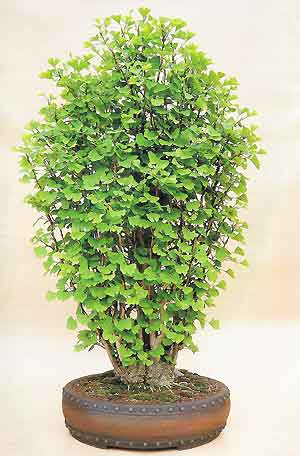
Feeding heavily, I allowed the lower shoots to extend, forming tall trees around the main trunk. The overall structure was greatly improved and I wired many of the shoots into place, creating the classic ginkgo 'candle flame' style. At this stage the bonsai was exhibited at a National show and received many favourable comments. I was very pleased with its overall appearance.
After growing well in the bonsai pot for a total of five years I decided to root prune that spring and was encouraged to see that the tree was completely pot bound, being full of healthy, thick coniferous-like fibrous roots. A hard root prune was carried out and the tree grew well that year, with even growth all over. By now the height, including the pot, was over 1 metre (3 feet) and the bonsai was becoming difficult to transport to exhibitions and society meetings. It has therefore not been publicly shown for several years.
This ginkgo will always remain a favourite bonsai tree in my collection. Despite a poor start, it has performed exceptionally well. Over the years I have got to know this tree intimately and am now able to control and predict its growth and I enjoy its very seasonal changes. The fact that it receives no insect or disease attacks is an added bonus. If I had to chose to keep just one of my bonsai, my ginkgo would without a doubt be that tree.
 The ginkgo is a much misunderstood tree, thought by many to be more of a curiosity rather than suitable as bonsai material. Although having leaves and being deciduous it is closely related to the conifer family. The tree has a fascinating history, being the sole survivor of a family of trees that flourished over 350 million years ago, hence an alternative name 'fossil tree'.
The ginkgo is a much misunderstood tree, thought by many to be more of a curiosity rather than suitable as bonsai material. Although having leaves and being deciduous it is closely related to the conifer family. The tree has a fascinating history, being the sole survivor of a family of trees that flourished over 350 million years ago, hence an alternative name 'fossil tree'. The tree had an interesting aged trunk, containing much 'chi chi' (trunk nodules), showing that it was very old and estimated to be around 80 years at that time. Although it was late summer, the branches were sparse and he said that it had not grown well that year as it was probably pot bound. I decided that I would never be able to create a mature trunk like this from a sapling ginkgo and was pleased that the bonsai needed much work, so that I could improve it myself. We bartered and agreed on a price.
The tree had an interesting aged trunk, containing much 'chi chi' (trunk nodules), showing that it was very old and estimated to be around 80 years at that time. Although it was late summer, the branches were sparse and he said that it had not grown well that year as it was probably pot bound. I decided that I would never be able to create a mature trunk like this from a sapling ginkgo and was pleased that the bonsai needed much work, so that I could improve it myself. We bartered and agreed on a price. The next day the ginkgo was carefully removed from its existing pot and I could not have imagined what I was going to find. I was completely stunned when almost all of the soil fell off, together with many decayed roots, leaving only a few large roots and virtually no fibrous roots to speak of. Despite having been under cover for a while, the peaty soil, which contained hardly any grit, was sodden and the tree was in a very sorry state.
The next day the ginkgo was carefully removed from its existing pot and I could not have imagined what I was going to find. I was completely stunned when almost all of the soil fell off, together with many decayed roots, leaving only a few large roots and virtually no fibrous roots to speak of. Despite having been under cover for a while, the peaty soil, which contained hardly any grit, was sodden and the tree was in a very sorry state. Ginkgo's are clearly very resilient as they would not have survived on the planet for so long had they not such a strong will to live. This was certainly apparent in this bonsai! I moved it outside and watered sparingly. The buds on the main part of the trunk were not growing at all, only the lower shoots. This was very unusual as normally a tree's most vigorous part is at the top, but not with this ginkgo, which had only one weak shoot growing near the top. I let the lower shoots grow unchecked all season so that the almost non-existent root system could begin to recover.
Ginkgo's are clearly very resilient as they would not have survived on the planet for so long had they not such a strong will to live. This was certainly apparent in this bonsai! I moved it outside and watered sparingly. The buds on the main part of the trunk were not growing at all, only the lower shoots. This was very unusual as normally a tree's most vigorous part is at the top, but not with this ginkgo, which had only one weak shoot growing near the top. I let the lower shoots grow unchecked all season so that the almost non-existent root system could begin to recover. Feeding heavily, I allowed the lower shoots to extend, forming tall trees around the main trunk. The overall structure was greatly improved and I wired many of the shoots into place, creating the classic ginkgo 'candle flame' style. At this stage the bonsai was exhibited at a National show and received many favourable comments. I was very pleased with its overall appearance.
Feeding heavily, I allowed the lower shoots to extend, forming tall trees around the main trunk. The overall structure was greatly improved and I wired many of the shoots into place, creating the classic ginkgo 'candle flame' style. At this stage the bonsai was exhibited at a National show and received many favourable comments. I was very pleased with its overall appearance.